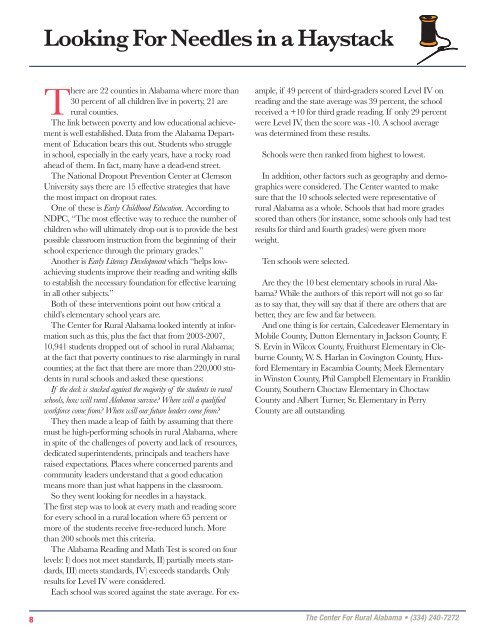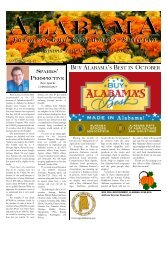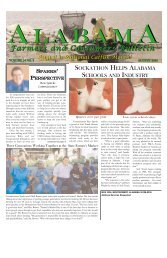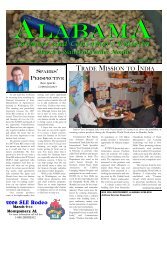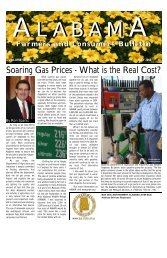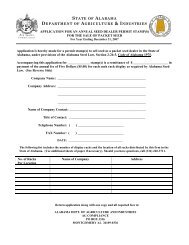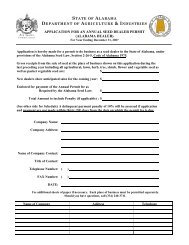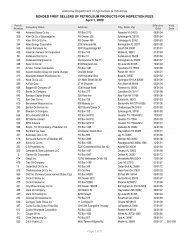Lessons Learned from Rural Schools - Alabama Department of ...
Lessons Learned from Rural Schools - Alabama Department of ...
Lessons Learned from Rural Schools - Alabama Department of ...
Create successful ePaper yourself
Turn your PDF publications into a flip-book with our unique Google optimized e-Paper software.
LLS-0010 <strong>Lessons</strong> <strong>Learned</strong>_Pub.qrk: 4/25/09 3:02 PM Page 8<br />
8<br />
Looking For Needles in a Haystack<br />
There are 22 counties in <strong>Alabama</strong> where more than<br />
30 percent <strong>of</strong> all children live in poverty, 21 are<br />
rural counties.<br />
The link between poverty and low educational achievement<br />
is well established. Data <strong>from</strong> the <strong>Alabama</strong> <strong>Department</strong><br />
<strong>of</strong> Education bears this out. Students who struggle<br />
in school, especially in the early years, have a rocky road<br />
ahead <strong>of</strong> them. In fact, many have a dead-end street.<br />
The National Dropout Prevention Center at Clemson<br />
University says there are 15 effective strategies that have<br />
the most impact on dropout rates.<br />
One <strong>of</strong> these is Early Childhood Education. According to<br />
NDPC, “The most effective way to reduce the number <strong>of</strong><br />
children who will ultimately drop out is to provide the best<br />
possible classroom instruction <strong>from</strong> the beginning <strong>of</strong> their<br />
school experience through the primary grades.”<br />
Another is Early Literacy Development which “helps lowachieving<br />
students improve their reading and writing skills<br />
to establish the necessary foundation for effective learning<br />
in all other subjects.”<br />
Both <strong>of</strong> these interventions point out how critical a<br />
child’s elementary school years are.<br />
The Center for <strong>Rural</strong> <strong>Alabama</strong> looked intently at information<br />
such as this, plus the fact that <strong>from</strong> 2003-2007,<br />
10,941 students dropped out <strong>of</strong> school in rural <strong>Alabama</strong>;<br />
at the fact that poverty continues to rise alarmingly in rural<br />
counties; at the fact that there are more than 220,000 students<br />
in rural schools and asked these questions:<br />
If the deck is stacked against the majority <strong>of</strong> the students in rural<br />
schools, how will rural <strong>Alabama</strong> survive? Where will a qualified<br />
workforce come <strong>from</strong>? Where will our future leaders come <strong>from</strong>?<br />
They then made a leap <strong>of</strong> faith by assuming that there<br />
must be high-performing schools in rural <strong>Alabama</strong>, where<br />
in spite <strong>of</strong> the challenges <strong>of</strong> poverty and lack <strong>of</strong> resources,<br />
dedicated superintendents, principals and teachers have<br />
raised expectations. Places where concerned parents and<br />
community leaders understand that a good education<br />
means more than just what happens in the classroom.<br />
So they went looking for needles in a haystack.<br />
The first step was to look at every math and reading score<br />
for every school in a rural location where 65 percent or<br />
more <strong>of</strong> the students receive free-reduced lunch. More<br />
than 200 schools met this criteria.<br />
The <strong>Alabama</strong> Reading and Math Test is scored on four<br />
levels: I) does not meet standards, II) partially meets standards,<br />
III) meets standards, IV) exceeds standards. Only<br />
results for Level IV were considered.<br />
Each school was scored against the state average. For ex-<br />
ample, if 49 percent <strong>of</strong> third-graders scored Level IV on<br />
reading and the state average was 39 percent, the school<br />
received a +10 for third grade reading. If only 29 percent<br />
were Level IV, then the score was -10. A school average<br />
was determined <strong>from</strong> these results.<br />
<strong>Schools</strong> were then ranked <strong>from</strong> highest to lowest.<br />
In addition, other factors such as geography and demographics<br />
were considered. The Center wanted to make<br />
sure that the 10 schools selected were representative <strong>of</strong><br />
rural <strong>Alabama</strong> as a whole. <strong>Schools</strong> that had more grades<br />
scored than others (for instance, some schools only had test<br />
results for third and fourth grades) were given more<br />
weight.<br />
Ten schools were selected.<br />
Are they the 10 best elementary schools in rural <strong>Alabama</strong>?<br />
While the authors <strong>of</strong> this report will not go so far<br />
as to say that, they will say that if there are others that are<br />
better, they are few and far between.<br />
And one thing is for certain, Calcedeaver Elementary in<br />
Mobile County, Dutton Elementary in Jackson County, F.<br />
S. Ervin in Wilcox County, Fruithurst Elementary in Cleburne<br />
County, W. S. Harlan in Covington County, Huxford<br />
Elementary in Escambia County, Meek Elementary<br />
in Winston County, Phil Campbell Elementary in Franklin<br />
County, Southern Choctaw Elementary in Choctaw<br />
County and Albert Turner, Sr. Elementary in Perry<br />
County are all outstanding.<br />
The Center For <strong>Rural</strong> <strong>Alabama</strong> • (334) 240-7272


